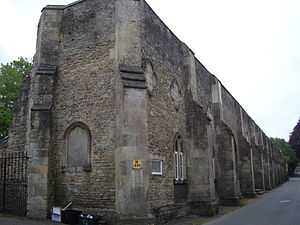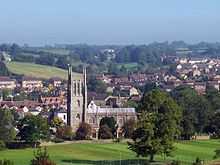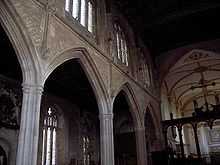Bruton Abbey



Bruton Abbey in Bruton, Somerset was founded as a house of Augustinian canons in about 1127, and became an abbey in 1511, shortly before its dissolution in 1539. The village then used the north aisle of the priory church as their parish church. It was endowed with manors, churches and other properties in the area and also in Normandy in France.
History
According to the sixteenth century antiquary John Leland, Bruton was founded in about 1005 as a Benedictine monastery, but it is not mentioned in the Domesday Book. It was founded as an Augustinian priory in about 1127.[1] In 1260 the priory exchanged its French possessions for land held by the Abbey of Troarn (nr Caen) at Runcton in Sussex and in Gloucestershire. There were many problems reported in the 15th century. John Schoyle became prior in 1419 and was accused in 1423 of having committed serious offences. In 1428 Bishop Stafford seems to have removed Schoyle from office, and in 1429, the latter was sent to live at the house of Augustinian Canons at Poughley in Berkshire. His successor, Richard of Glastonbury, proved to be equally troublesome: in 1430 and again in 1444, inquiries were conducted into charges of immorality against the prior and the whole community. Under a later reforming prior various rules were introduced bans on the canons were sleeping away from the house without permission, on hunting and dice playing, and on women in the monastery.
Bruton became an abbey in 1511. There were problems both inside and outside the monastery leading up to its dissolution in 1539. The abbot, Ely, was the subject of criminal accusations and even plots against his life, and later in the year became a prisoner in the Tower of London.
The Dovecote which overlooks Bruton was built in the 16th century. It was at one time used as a house, possibly as a watchtower and as a dovecote. It is a Grade II* listed building[2] and ancient monument.[3][1] It is managed by the National Trust. The building was once within the deerpark of the Abbey and was adapted by the monks from a gabled Tudor tower.[4] The conversion to be a dovecote took place around 1780.[5] It has over 200 pigeon holes.[6]
After Dissolution
On dissolution, the abbey was granted to a John Drew of Bristol, but later transferred to Sir Maurice Berkeley. The latter built a house on the site incorporating some of the buildings, but this was demolished in 1786. Sir Maurice was a prominent courtier and his impressive Renaissance-inspired tomb and those of his wives are retained in the later chancel. The present parish church is mainly a 14th-15th century structure. An unusual feature is that the chancel at some point was rebuilt in a light, airy Georgian style, which contrasts rather strangely with the medieval remainder. Some believe the latter was part of the original abbey church, but it is generally thought more likely that that was a separate adjacent building.
References
- ↑ 1.0 1.1 "Bruton Abbey". Pastscape. English Heritage. Retrieved 30 December 2013.
- ↑ "Dovecote about 370 metres South of Bruton Church". National Heritage List for England. English Heritage. Retrieved 30 December 2013.
- ↑ "Dovecote, about 370 metres South of Bruton Church (also known as Pigeon Tower), Park Wall (North side), Bruton". Somerset Historic Environment Record. Somerset County Council. Retrieved 30 December 2013.
- ↑ Greeves, Lydia (2013). Houses of the National Trust. London: National Trust Books. p. 364. ISBN 9781907892486.
- ↑ "Tower, S of the church, Bruton". Somerset Historic Environment Record. Somerset County Council. Retrieved 30 December 2013.
- ↑ "Bruton Dovecote". Somerset Routes. Retrieved 30 December 2013.
- 'Houses of Augustinian canons: The priories of Bruton and Burtle Moor', A History of the County of Somerset: Volume 2 (1911), pp. 134–39.
- Anthony New. 'A Guide to the Abbeys of England And Wales', p81-82. Constable.
- Colin Platt. 'The Travellers Guide to Medieval England', p132. Secker & Warburg.
External links
![]() Media related to Bruton Abbey at Wikimedia Commons
Media related to Bruton Abbey at Wikimedia Commons
See also
Coordinates: 51°06′40″N 2°27′07″W / 51.111°N 2.452°W